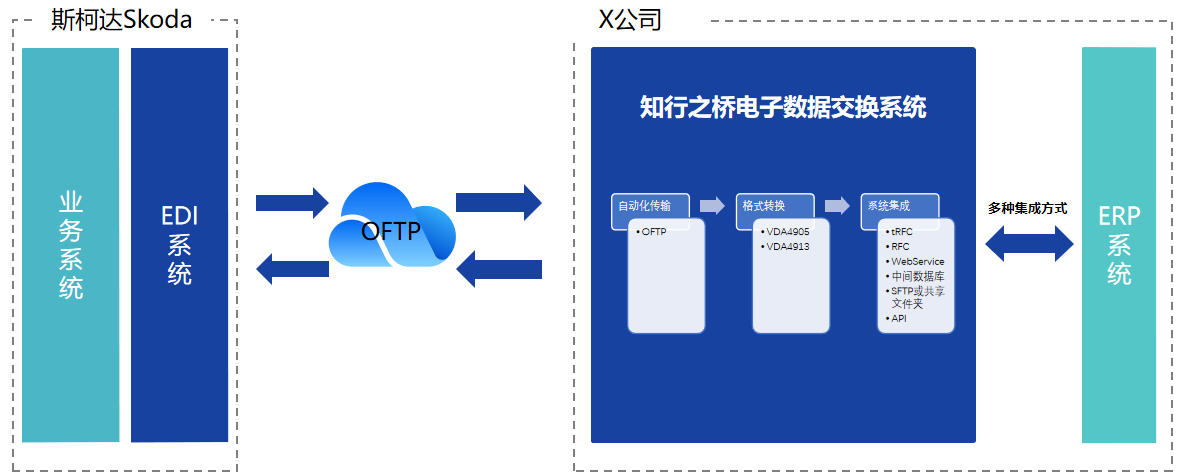Volkswagen has a prominent position in the automotive industry in terms of global sales leadership, technological innovation, quality benchmarking, multi-brand strategy and sustainable development. As a car manufacturer with global influence, Volkswagen plays an important role in shaping the development of the automotive industry and leading the future direction of mobility.
At present, we have helped customers in the automotive industry to successfully connect with Volkswagen's brands: Volkswagen , Volkswagen Mexico , Audi , Porsche , etc. Today's article mainly introduces how to establish an EDI connection with Volkswagen's sub-brand: Skoda.

project requirements
Skoda Skoda is consistent with its parent company Volkswagen in EDI transmission protocol and message standard.
Transmission protocol: OFTP
message standard: VDA
The automotive industry operates according to strict VDA message standards, which define every detail of the vehicle production chain from start to finish. The rigor with which each assembly stage is executed depends largely on the efficiency of communication between the different partners in the supply chain. Electronic Data Interchange (EDI) is currently trending towards the standardization of domain-specific VDA messages. Its purpose is to make data exchange more efficient, thereby improving original equipment manufacturer (OEM) requirements.
message type
| Business code | business meaning | Transmission direction |
| VDA4905 | Material Requirements Planning | Skoda Skoda sent to Company X |
| VDA4913 | Shipping notice | Company X sent to Skoda |
How does Zhixingzhiqiao EDI system connect with Skoda's EDI system?
Build an EDI transmission channel
Through the OFTP port of Zhixingzhiqiao EDI system, the EDI transmission channel with Skoda can be established.
The following information needs to be prepared:
- SSID: SSID is the unique identity in OFTP data transmission, that is, the ODETTE ID that is applied for purchase from ODETTE. This value will be included in the sent request to identify the sender and can be addressed to the relevant OFTP port when receiving the message.
- Password: The password matching the SSID. This password is a custom value, you only need to ensure that the same value is configured in the trading partner system, and the length does not exceed 8 characters.
- Remote Host: The host name or IP address of the remote OFTP server.
- Port: Port to connect to the remote OFTP server.
- Public Certificate: The public key certificate used for encryption when sending messages. The certificate must match the private key certificate of the trading partner, and the trading partner should provide this public key certificate when sharing OFTP detailed configuration information.
After configuring OFTP related information, it is necessary to conduct a connection test with Skoda to ensure that both parties can send and receive files normally.
Realize the format conversion of EDI files
After setting up the EDI transmission channel, the data can be transmitted. The Skoda EDI project needs to transmit files conforming to the VDA international message standard, so the enterprise needs to have the ability to generate VDA messages. In the Zhixingzhiqiao EDI system, the conversion between VDA and XML can be realized through the VDA port and the XMLMap port. It should be noted that after completing the EDI mapping and format conversion for VDA4905 and VDA4913, it is necessary to conduct an EDI business test with Skoda, mainly to verify whether the format of the EDI message to be transmitted and the business content to be transmitted meet the requirements of Skoda.
system integration
Suppliers need to cooperate with Skoda to complete the two steps of building transmission channels and EDI format conversion, but in the system integration link, different integration solutions can be selected according to the actual needs of suppliers.
System integration mainly realizes the integration between the supplier's internal business system and the EDI system, that is, how to efficiently and conveniently provide the supplier's business data to the EDI system and how the EDI system provides the data sent by Skoda to the supplier.
For some enterprises without ERP and with a small order volume, you can choose Excel/CSV/XML and other visual formats or SaaS services; for those with internal business systems and large data volumes, common integration methods include intermediate databases, APIs, and Webservices wait.
How can EDI help the automotive industry?
The automotive industry combines EDI (Electronic Data Interchange) with its supply chain management system to achieve efficient supply chain collaboration and data exchange. The following are some practices in the application of EDI in the automotive industry:
Order Management: EDI is used between car manufacturers and suppliers to handle the order management process. Through EDI, orders can be sent electronically from the manufacturer to the supplier, enabling real-time order confirmation, changes and cancellations. This reduces traditional paper-based document handling and improves order processing speed and accuracy.
Shipping notifications and shipping management: EDI can be used to send shipping notifications and manage logistics shipments. Suppliers can provide shipment notifications to manufacturers via EDI, including ship date, shipping method, and tracking information. At the same time, EDI can also be integrated with the logistics transportation system to realize real-time sharing and monitoring of transportation data.
Inventory management and forecasting: Automakers and suppliers can collaborate on inventory management and demand forecasting through EDI. EDI can be used to share inventory data, sales data and production plans to help all parties in the supply chain understand inventory levels, demand conditions and production plans in real time, so as to better manage inventory and adjust production.
Invoice and Payment Processing: EDI can also be used for the automation of invoice and payment processing. Suppliers can send electronic invoices to manufacturers via EDI, eliminating the steps of manual processing and mailing of paper invoices. At the same time, EDI can also be integrated with the financial system of the enterprise to realize the automatic matching and processing of invoices and payments.
For more information on EDI, please refer to: What is EDI?